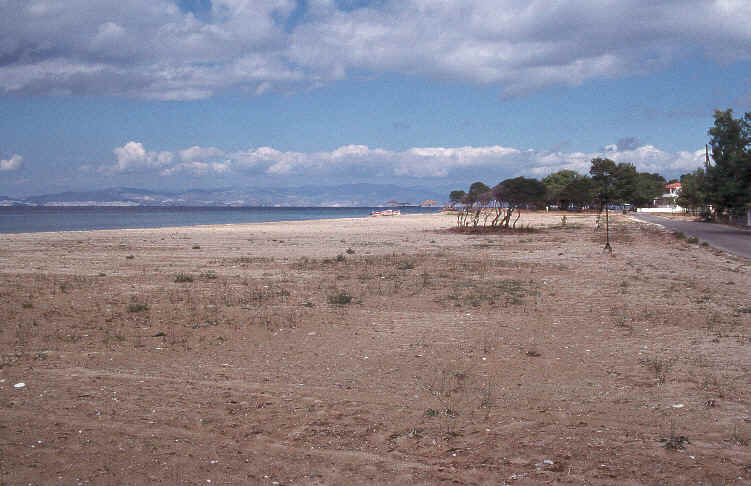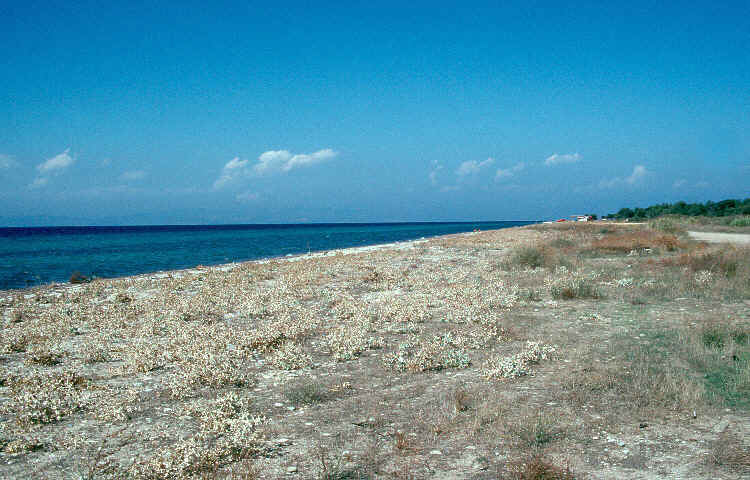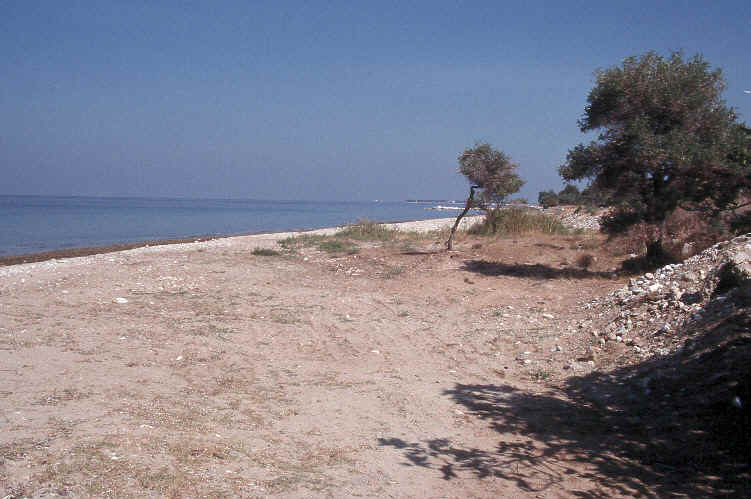|
Description / Habitats / Flora / Vertebrates / Insects / Invertebrates / What's that Bug? Home / Nestos Delta / Bibliography / About this site / Links / Contents / Galleries ____________________________________________________________________________ |
|
Natura 2000 ______________________________________________________________________
CONSERVATION ISSUES Beaches throughout the Mediterranean face enormous pressures from the tourist industry. High profile species, such as breeding turtles, have drawn attention to the loss of habitat but this attention tends to be focused on a few key localities whilst elsewhere damage goes largely unnoticed. Although the soft coast habitats of Thásos may not support any internationally endangered species, they are none the less important for the conservation of the island's biodiversity. Many plants and animals on Thásos will be confined to the dunes and sandy grasslands around the coastal fringe, but their populations are steadily declining as resorts expand and increasing tourist pressure threatens more and more remote beaches. The island has many small coves with quiet beaches and as long as these are safeguarded from the most damaging effects of tourism then characteristic coastal species will survive. However, some species will be dependent upon the largest undisturbed habitats and the few sizeable fragments remaining on Thásos should be given as much protection as possible. The best of these sites are the dunes at Skala Potamias and the sandy grassland at Cap Prinos, both of which face threats from development. Encroachment by tavernas and apartments at Skala Potamias seems to have slowed down recently, but the construction of a new tarmac road to the beach suggests that demand for tourist expansion may also follow. Hopefully the area of dunes will be excluded from any planning applications (though the pastures behind the beach are also extremely important wildlife habitats and should be similarly protected). The undisturbed beach at Cap Prinos has only recently (c.2000) been targeted for development with the construction of a new 5-star hotel in the centre of the beach. This has inevitably resulted in increased tourist pressure and trampling damage on the foreshore, accompanied by the totally unnecessary levelling of the northern half of the beach. This senseless act (I can only think it was undertaken to remove the inconvenience of the sea holly Eryngium maritimum stands), has destroyed the natural vegetation and topography of this stretch of beach and will have had a substantial impact on the coastal wildlife. The beach should be left to recover, which it could do in time, and the section to the south of the new hotel protected from any similar damaging activities.
2001 2018 [The above was written back in 2013, and inevitably the situation has got worse. The Ilio Mare Beach Hotel has completed its remodelling of the foreshore, such that nothing now remains of the strandline vegetation on their beachfront. To the south, the undisturbed end of Cap Prinos beach is now occupied by the Natura Beach Bar. It claims to be eco-friendly, but as they've steadily obliterated the biodiverse sandy grassland here as their enterprise expands to take in a volleyball court, car parking and a festival site, it is hard to see which bit of ecology they are being friendly to.
1995 2018 Smaller beaches also have their value. A small strip of sand to the north of Skala Kallirachis had the best developed example of natural coastal vegetation that I have seen on Thásos and was home to an abundance of grasshoppers, beetles, butterflies and other insects characteristic of such habitats. Recently (2001) the majority of this area has been flattened, apparently by four-wheeled drive vehicles driving down a small track some ten metres or so onto the beach. This damage has no doubt been undertaken through ignorance and it would surely be no hardship for drivers to park in the lay-by and walk the short distance to the shore. By May 2003 there had been some recovery of the vegetation communities at Skala Kallirachis and given a few more years from disturbance this beach may regain much of its former significance, but it is possible that some species will have been permanently lost. In 2016 this beach appeared to be neglected and was starting to scrub over. A brief visit suggested that it still supported a rich fauna and flora and the habitat may be rejuvenated from winter storms at some stage in the years ahead.
1999 2001 2016 These are naturally scarce on Thásos and all remaining examples are comparatively small and vulnerable. The main sites are the wet grasslands at Skala Potamias, the sedge swamp at Chrissi Ammoudia, the valley fen on the outskirts of Limenas, and the reedbeds between Prinos and Rachoni. Wetlands host high levels of biodiversity in all regions and this is especially marked in the Mediterranean. Unfortunately there has been little documentation of the fauna and flora that existed in these habitats but the recent discoveries of such important species as summer snowflake Leucojum aestivum and the whorl snails Vertigo angustior and Vertigo moulinsiana demonstrate the richness that still survives. Given the scarcity of habitats to support wetland plants and animals these remaining examples must be protected from habitat destruction or the deterioration of habitat quality as a result of pollution or changes in land use. However, all of the above named localities are threatened and should be the subject of conservation planning and remedial action as soon as possible. The most threatened of these is the tall sedge swamp at Chrissi Ammoudia. Amongst the tall sedge fen in this tiny area is an abundance of summer snowflake, an uncommon plant in the Mediterranean generally and here at its only location on Thásos. It requires a permanently high water table and this small fen is very unusual on Thásos, where everything is usually so dry during the summer months. So far developments in the area have remarkably left this corner intact but it is surrounded by new tourist apartments in the rapidly expanding Golden Beach complex and it is perhaps only a matter of time before it too falls victim of economic progress. Further down the beach the damp grasslands of the colluvial flats between Skala Potamias and Chrissi Ammoudia are steadily being lost as new apartments appear and traditional grazing patterns are abandoned. Many species must have already become extinct in this area over the past couple of decades and urgent action is necessary in order to control the escalating tourist development associated with Golden Beach and its environs. The demise of the valley fen at Thassos Town is already underway as this wetland is becoming shaded by scrub growth. This is probably a result of alterations to the hydrology as a result of the dumping of marble spoil at the southern end of the valley and dumping of inert landfill at the northern end. Changes to water quality can also be expected and this will accelerate succession as the nutrient status of the groundwater deteriorates. It is only very recently that this fen has been shown to support Desmoulin's and narrow-mouthed whorl snails, both listed in the EU Habitats & Species Directive, and there is also a stand of great horsetail Equisetum telmataeia which is not known elsewhere on the island. The future of this important site is bleak unless dumping is stopped and management carried out to remove invading scrub. I have not visited the reedswamp south of Rachoni but a similar area behind the beach at Cap Prinos has been drained and now supports impoverished damp grassland and dry reedbeds. North of Prinos I am told that there are still good quality wetland habitats amongst the reedswamp but plans have been recently mooted to drain some of this for commercial tomato production. This would indeed be a tragedy if a functioning wetland ecosystem is destroyed for an inappropriate business venture - the humble tomato has a lot to answer for in terms of natural habitat lost around the Mediterranean and in places like the Canary Islands! It would be far better if Thásos utilised this wetland for the benefit of both the local community and wildlife by developing eco-tourism in the area and showing visitors the biological riches of Aegean wetlands. OTHER HABITATS: Floristically rich dry grassland habitats appear to be uncommon on Thásos but the true extent will not be known until detailed habitat surveys take place in the lowlands. My experience is mainly confined to the north-east of the island around Thassos Town and here grassland is distinctly scarce away apart from those examples occurring beneath the ancient olive groves. Succssion to Cistus phrygana is presumably rapid on suitable soils whilst heavy sheep and goat grazing alters the botanical composition of many examples in favour of spiny herbs and sub-shrubs. Excluding damp types, such as that found at Thassos Agora and Skala Potamias, biologically rich grasslands are scattered and usually small in extent. The most attractive pasture I have seen is a small glade in the main Thassos Valley where spotted rockrose Tuberaria guttata is frequent. There are reports of good grassland at Cap Pachys to the west of Thassos Town but I have not visited this area yet and would welcome information from any visitors who manage to locate it. If this apparent paucity is real then dry grasslands should be regarded as a conservation priority on the island as they must surely have declined considerably in extent in recent years. Lowland scrub communities are probably under no particular threat at present as garigue and maquis is widespread around the island. However, most garigue is Cistus-dominated and examples of other variants are much rarer on Thásos. The locations of such examples, for instance the 'Eastern thorny garigue' at Evariocastro at the eastern end of Thassos Town, should be documented and if they prove to be uncommon on the island then they should be protected from damaging activites. The form of maquis that appears to be most threatened is the type of shibylak that is associated with neglected olive groves. There have been substantial losses of this habitat around the fringes of Thassos Town in recent years as a result of the building of new appartments and developments associated with the westwards extension of the port and if this destruction is mirrored elsewhere on the island then action should be taken to ensure that the better examples are conserved. Damaging fires over the last couple of decades have significantly reduced pine woodland cover on the island but in most places regeneration is rapid and conifers will undoubtedly still dominate much of the landscape in the years ahead. Most of this woodland is commercially managed and it would be wise for the timber producers to initiate a conservation strategy that recognised the considerable advances across Europe in maximising biodiversity in harness with forestry operations. Specifically there should be a strategy for the retention of dead wood and over-mature trees within forest plots to esnure that the saproxylic fauna is catered for. Grazing is another problem issue in the pine forests as many areas are almost denuded of ground flora - efforts to relax grazing intensity would lead to substantial gains for wildlife. In many places in the uplands there is little or no regeneration of the important black pine forests at high altitudes and the loss of these valuable habitats would be unforgiveable. Broadleaf woodlands are a minor component of the woodland cover on Thásos but are of high conservation value for a wide range of species. Of special significance are the few examples of ancient oak, chestnut and plane woodland at Panagia, Kazaviti and Limenas respectively. The Limenas planes are probably secure in their isolated and natural setting but the Panagia and Kazaviti woods should be given greater attention with regard to the retention of dead and fallen trees and the establishment of planting programmes for long-term continuity of age structure. Grazing and road construction are the most obvious threats in the uplands. many upland species on Thásos will be confined to small areas where geology and hydrology combine to provide the right environmental conditions. Without surveys to determine where these key biodiversity sites are there is always a danger that the construction of forest tracks or firebreaks could unwittingly destroy important sites and potentially cause the extinction of valuable species, including endemics. Heavy sheep grazing leads to the impoverishment of upland pastures and so far I have not found any botanically rich upland grasslands in my visits to the mountains. If such areas survive then they should be protected as they are highly likely to support rich faunas and floras. Meanwhile any efforts to reduce grazing density in the uplands generally should be welcomed. The impact of the marble quarries should also be examined and the industry should be encouraged to work with the timber producers to develop a strategy for conservation which lessens their impacts in the heart of the island. The natural beauty of Thásos is dominated by its forests and mountains but its lowland habitats also contribute significantly to enjoyment of its landscape and the conservation of its wildlife. An important part of the appeal of Thásos in the tourist market lies in its natural resources and the contribution of its wildlife and natural habitats should be seen as a vital element in sustaining this appeal. Efforts should be made to ensure that the desire to maximise economic benefits from the tourist industry does not lead to the destruction of habitats and extinction of wildlife as a consequence. An article by Dr Thomas Schultze-Westrum, addressing the conservation and landscape issues facing Thásos, appeared (in Greek) in the April 2004 edition of the island's local newspaper and can be downloaded here 'ΑΝΑΠΤΥΞΗ & ΠΡΟΣΤΑΣΙΑ ΤΗΣ ΦΥΣΗΣ ΣΤΗ ΘΑΣΟ' or, in English in rtf format, here 'NATURE CONSERVATION ON THASSOS'.
|







-474-1020x681.JPG)








